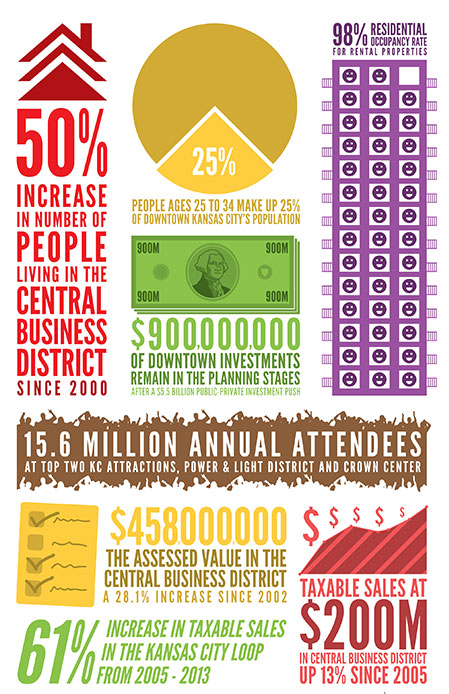HOME | ABOUT US | MEDIA KIT | CONTACT US | INQUIRE
HOME | ABOUT US | MEDIA KIT | CONTACT US | INQUIRE

Downtown Kansas City has seen a lot of changes in the past decade and a half. It has traded in a drab facade, empty parking lots and the occasional rolling tumbleweed for a colorful and vibrant place where the community comes to share in sporting events, concerts, theater, arts and cuisine.
The sidewalks are no longer rolled up at sunset.
With areas like the Crossroads Arts District, Power and Light District and massive venues like the Sprint Center and the Kauffman Center for the Performing Arts, it’s no surprise that Downtown Kansas City is becoming a place where people want to live.
Rick Usher, assistant city manager for Kansas City says the growth of the area is truly a result of a group effort. “The collaboration between the city, Downtown Council and Downtown Ambassadors has worked together for a common goal of clean, safe and green,” he said.
Sean O’Byrne, vice president for business development at the Downtown Council, said multiple factors go into creating a thriving Downtown. “It’s not what it used to be, which was a commercial center,” he said. “Today, it takes retail, residential and entertainment.”
The Downtown Council, in the early stages of revitalization, sent out surveys to find out what dif-
ferent residents and property owners wanted in the area. The first items weren’t unlike things you’d see on a suburbanite’s checklist: grocery, entertainment, schools.
“Over the past few years, we’ve given them those in spades,” O’Byrne said.
Additions like Cosentino’s Market, Crossroads Academy and the Power & Light District are helping elevate downtown residency statistics. The population Downtown charged from 3,000 to 20,000 in a decade, and advocates suggest it will be more than 40,000 soon after the streetcar gets rolls in 2016.
O’Byrne said the residential occupancy rate is at 98 percent and rents are climbing. “Downtown should have the highest rents,” he said, “because the amenity package is second to none.”
O’Byrne believes that Downtown can deliver on the 40,000-resident goal, with longevity as key factor. “With early childhood education coming in, Crossroads Academy, and potentially a high school, residents will have all of the bases covered,” he said.
Millennials, ages 25 to 34, make up 25 percent of Downtown residents according to realty brokerage Cassidy Turley.
“We are starting to see changing trends and the most exciting will be over the next 10 years,” O’Byrne said.